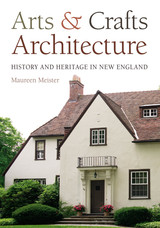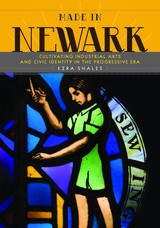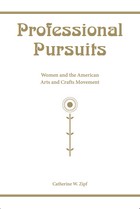3 books about Arts and crafts movement

Arts and Crafts Architecture
History and Heritage in New England
Maureen Meister
University Press of New England, 2014
This book offers the first full-scale examination of the architecture associated with the Arts and Crafts movement that spread throughout New England at the turn of the twentieth century. Although interest in the Arts and Crafts movement has grown since the 1970s, the literature on New England has focused on craft production. Meister traces the history of the movement from its origins in mid-nineteenth-century England to its arrival in the United States and describes how Boston architects including H. H. Richardson embraced its tenets in the 1870s and 1880s. She then turns to the next generation of designers, examining buildings by twelve of the region’s most prominent architects, eleven men and a woman, who assumed leadership roles in the Society of Arts and Crafts, founded in Boston in 1897. Among them are Ralph Adams Cram, Lois Lilley Howe, Charles Maginnis, and H. Langford Warren. They promoted designs based on historical precedent and the region’s heritage while encouraging well-executed ornament. Meister also discusses revered cultural personalities who influenced the architects, notably Ralph Waldo Emerson and art historian Charles Eliot Norton, as well as contemporaries who shared their concerns, such as Louis Brandeis. Conservative though the architects were in the styles they favored, they also were forward-looking, blending Arts and Crafts values with Progressive Era idealism. Open to new materials and building types, they made lasting contributions, with many of their designs now landmarks honored in cities and towns across New England.
[more]

Made in Newark
Cultivating Industrial Arts and Civic Identity in the Progressive Era
Shales, Ezra
Rutgers University Press, 2010
What does it mean to turn the public library or museum into a civic forum? Made in Newark describes a turbulent industrial city at the dawn of the twentieth century and the ways it inspired the library's outspoken director, John Cotton Dana, to collaborate with industrialists, social workers, educators, and New Women.
This is the story of experimental exhibitions in the library and the founding of the Newark Museum Associationùa project in which cultural literacy was intertwined with civics and consumption. Local artisans demonstrated crafts, connecting the cultural institution to the department store, school, and factory, all of which invoked the ideal of municipal patriotism. Today, as cultural institutions reappraise their relevance, Made in Newark explores precedents for contemporary debates over the ways the library and museum engage communities, define heritage in a multicultural era, and add value to the economy.
This is the story of experimental exhibitions in the library and the founding of the Newark Museum Associationùa project in which cultural literacy was intertwined with civics and consumption. Local artisans demonstrated crafts, connecting the cultural institution to the department store, school, and factory, all of which invoked the ideal of municipal patriotism. Today, as cultural institutions reappraise their relevance, Made in Newark explores precedents for contemporary debates over the ways the library and museum engage communities, define heritage in a multicultural era, and add value to the economy.
[more]

Professional Pursuits
Women and the American Arts and Crafts Movement
Catherine W. Zipf
University of Tennessee Press, 2009
The Victorian era provided few opportunities for women in the professional world. The American Arts and Crafts movement, which began in the late nineteenth century to promote handcraftsmanship over mass production, was a major factor in changing the status of women as professional workers. In <i>Professional Pursuits</i>, Catherine Zipf examines the participation of women in this significant design movement and the role they played in revolutionizing the position of women in the professional world. She also shows how, in turn, the Arts and Crafts movement set the stage for social and political change in future years.
Zipf focuses on five gifted women in various parts of the country. In San Diego, Hazel Wood Waterman parlayed her Arts and Crafts training into a career in architecture. Cincinnati's Mary Louise McLaughlin expanded on her interest in Arts and Crafts pottery by inventing new ceramic technology.
New York's Candace Wheeler established four businesses that used Arts and Crafts production to help other women earn a living. In Syracuse, both Adelaide Alsop Robineau and Irene Sargent were responsible for disseminating Arts and Crafts-related information through the movement's publications. Each woman's story is different, but each played an important part in the creation of professional opportunities for women in a male-dominated society.
<i>Professional Pursuits</i> will be of interest to scholars and students of material culture and of the Arts and Crafts movement. More importantly, it chronicles a very significant, little-understood aspect of the development of Victorian capitalism: the integration of women into the professional workforce.
Catherine Zipf is an assistant professor in the Department of Cultural and Historic Preservation at Salve Regina University. She has published articles in <i>Women's Art News</i> and the <i>Journal of the Society of Architectural Historians</i>.
Zipf focuses on five gifted women in various parts of the country. In San Diego, Hazel Wood Waterman parlayed her Arts and Crafts training into a career in architecture. Cincinnati's Mary Louise McLaughlin expanded on her interest in Arts and Crafts pottery by inventing new ceramic technology.
New York's Candace Wheeler established four businesses that used Arts and Crafts production to help other women earn a living. In Syracuse, both Adelaide Alsop Robineau and Irene Sargent were responsible for disseminating Arts and Crafts-related information through the movement's publications. Each woman's story is different, but each played an important part in the creation of professional opportunities for women in a male-dominated society.
<i>Professional Pursuits</i> will be of interest to scholars and students of material culture and of the Arts and Crafts movement. More importantly, it chronicles a very significant, little-understood aspect of the development of Victorian capitalism: the integration of women into the professional workforce.
Catherine Zipf is an assistant professor in the Department of Cultural and Historic Preservation at Salve Regina University. She has published articles in <i>Women's Art News</i> and the <i>Journal of the Society of Architectural Historians</i>.
[more]
READERS
Browse our collection.
PUBLISHERS
See BiblioVault's publisher services.
STUDENT SERVICES
Files for college accessibility offices.
UChicago Accessibility Resources
home | accessibility | search | about | contact us
BiblioVault ® 2001 - 2024
The University of Chicago Press









